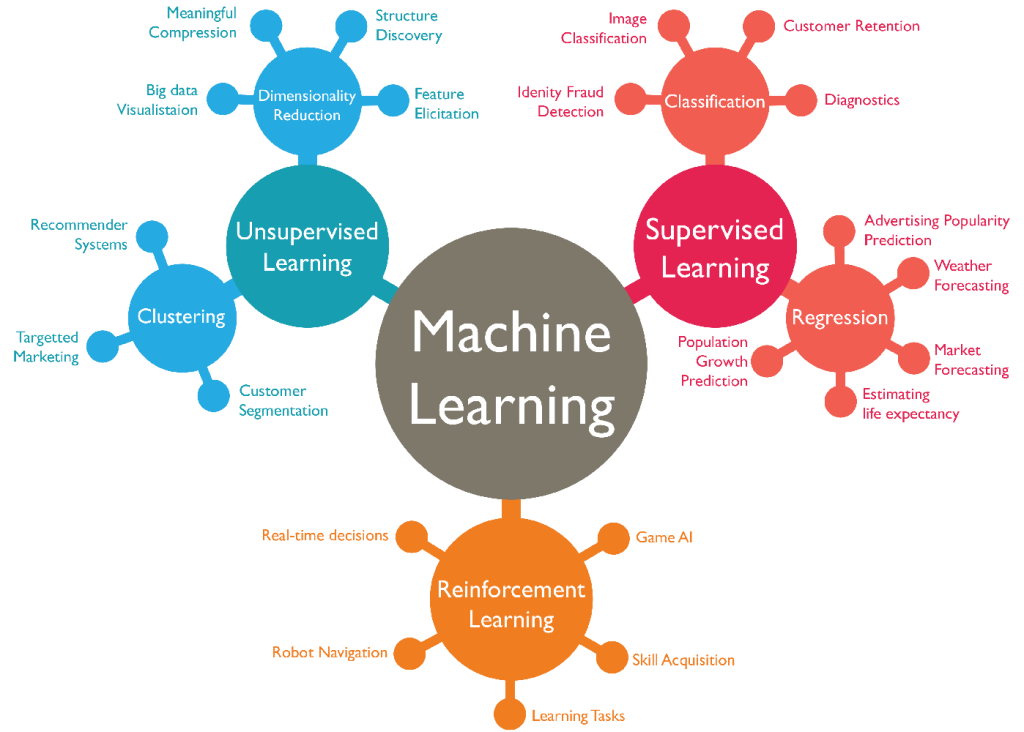What is Machine Learning:
Machine learning is a subfield of artificial intelligence (AI) that focuses on the development of algorithms and models that enable computers to learn and make predictions or decisions without being explicitly programmed. It is based on the idea that machines can learn from data, identify patterns, and make intelligent decisions or predictions. Machine Learning Languages
Instead of relying on explicit instructions, machine learning algorithms learn from examples or experiences provided in the form of a training dataset. The algorithm analyzes the data, identifies patterns or relationships, and builds a model that generalizes from the given examples. This model can then be used to make predictions or decisions on new, unseen data.
Machine learning algorithms can be broadly categorized into three types: supervised learning, unsupervised learning, and reinforcement learning. Machine Learning Languages

Supervised learning:
In supervised learning, the algorithm is trained on labeled examples, where each example consists of input data (features) and the corresponding desired output (labels). The algorithm learns to map the input data to the correct output by minimizing the error between its predictions and the actual labels. Supervised learning is commonly used for tasks like classification (assigning labels to inputs) and regression (predicting continuous values).
Unsupervised learning:
In unsupervised learning, the algorithm is provided with unlabeled data and must find patterns or structures within the data. It explores the data’s inherent structure or relationships without any predefined labels. Common tasks in unsupervised learning include clustering (grouping similar data points together) and dimensionality reduction (representing high-dimensional data in a lower-dimensional space).
Reinforcement learning:
Reinforcement learning involves an agent interacting with an environment and learning through trial and error. The agent takes actions in the environment and receives feedback in the form of rewards or penalties. The goal of the agent is to learn the optimal actions or policies that maximize the cumulative reward over time. Reinforcement learning is often used in scenarios where there is no labeled data, and the agent must learn from its own actions. Machine Learning Languages
Machine learning has numerous applications across various domains, including image and speech recognition, natural language processing, recommendation systems, fraud detection, autonomous vehicles, and many others. It continues to advance and evolve, enabling computers to learn and improve their performance on complex tasks without explicit programming. Machine Learning Languages

Top 10 Languages for Machine Learning in 2023:
Python:
Python is the most widely used programming language for machine learning. It offers a rich ecosystem of libraries and frameworks such as TensorFlow, PyTorch, scikit-learn, and Keras, making it highly versatile and suitable for various machine learning tasks.
R:
R is a language specifically designed for statistical computing and graphics. It has a wide range of packages and tools for machine learning and statistical analysis. R is often preferred for academic and research purposes.
Java:
Java is a general-purpose programming language that is widely used in enterprise applications. It has several machine learning libraries like Deeplearning4j and Weka, making it suitable for large-scale applications.
C++:
C++ is a high-performance programming language commonly used in systems programming and resource-constrained environments. It provides efficient implementations of machine learning algorithms and is popular in areas such as computer vision and robotics.
Julia:
Julia is a relatively new language designed for high-performance numerical computing. It combines the ease of use of Python with the speed of languages like C++. Julia’s performance and extensive collection of packages make it attractive for machine learning tasks.
MATLAB:
MATLAB is a proprietary programming language widely used in academia and industry for numerical computing and data analysis. It has comprehensive toolboxes for machine learning and provides an interactive environment for prototyping and experimentation.
Scala:
Scala is a statically typed programming language that runs on the Java Virtual Machine (JVM). It is often used in big data processing frameworks like Apache Spark, which has built-in machine learning libraries.
JavaScript:
JavaScript is primarily a web development language, but it has gained popularity in the machine learning community. Libraries like TensorFlow.js and Brain.js enable machine learning in the browser and Node.js environments.
C#:
C# (C Sharp) is a general-purpose programming language developed by Microsoft. It has gained traction in machine learning with frameworks like ML.NET, which provides machine learning capabilities for .NET developers.
Go:
Go (or Golang) is a language developed by Google known for its simplicity and efficiency. Although not as widely used as Python or R in machine learning, Go has gained popularity due to its performance and concurrent processing capabilities.
Please keep in mind that this ranking may have changed or shifted by the time, so it’s important to stay updated with the latest trends in the machine learning community.

Salary of a Machine learning Developer:
The salary of a machine learning developer can vary significantly based on several factors such as location, level of experience, industry, company size, and skillset. However, in general, machine learning developers tend to earn higher-than-average salaries due to the specialized nature of their work.
According to available salary data, in September 2021, the average annual salary of a machine learning developer in the United States ranged from around $90,000 to $150,000. However, it’s important to note that these figures are averages, and salaries can be higher or lower depending on the aforementioned factors.
For more updates stay with boardofjobs.com


